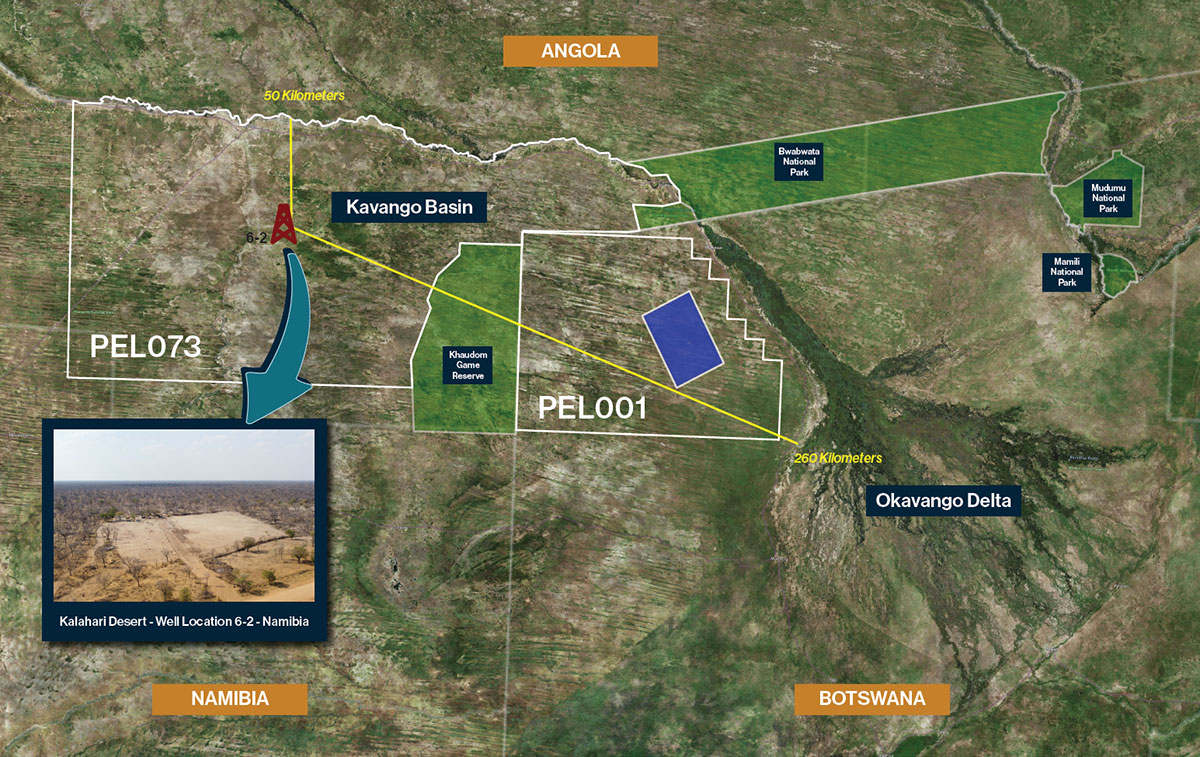- Reconnaissance Energy Africa, an oil and gas company with headquarters in Canada, has recently begun exploratory drilling in northern Namibia.
- Conservationists and local communities are concerned over the potential environmental impact that oil and gas extraction could have on such an important ecosystem.
- Northern Namibia and Botswana have a number of interconnected watersheds including the Okavango Delta – the potential for pollutants to enter watercourses and spread throughout the region are a particular concern.
On December 21, Reconnaissance Energy Africa (Recon Africa) announced that it had begun exploratory drilling for oil and gas in the Namibian portion of the Kavango-Zambezi Transfrontier Conservation Area (KAZA). The move has alarmed environmental campaigners and community groups who are concerned about the impact this could have on the region’s watercourses, people and wildlife.
Recon Africa is the holder of a licence to explore a 2.5 million hectare area (6.3-million-acres) of northeastern Namibia, granted to a predecessor company in January 2015. The majority of the area covered by Petroleum Exploration Licence (PEL) 73 sits in the KAZA, a conservation initiative covering 520,000 square kilometres (201,000 square miles) of Angola, Botswana, Namibia, Zambia and Zimbabwe. The company also has a licence to prospect for oil in another section of KAZA, 1 million hectare area (2.5 million acres) of northwestern Botswana, where it hopes to begin drilling in 2021.

Concerns
The KAZA conservation area is home to the largest remaining population of African elephants and is one of the last remaining strongholds of the African wild dog (Lycaon pictus). Recon Africa’s exploration areas in both Botswana and Namibia fall largely within the Okavango River Basin which flows into the richly-biodiverse Okavango Delta — a UNESCO World Heritage site. Conservationists are particularly concerned by the potential impact drilling for oil and gas here could have on the interconnected watercourses of the river basin.
“There is a serious lack of knowledge on groundwater resources in the target oil and gas extraction area,” said Surina Esterhuyse, a geohydrologist at the University of the Free State, South Africa. “In Botswana, the Okavango river basin is still relatively pristine, but the planned exploration and extraction could have serious impacts on the [Okavango] delta.”
Recon Africa is drilling into a 9,000-meter-deep sedimentary basin known to geologists as the Kavango Basin to establish whether there is actually oil beneath the KAZA, and if these resources can be economically exploited. Daniel Jarvie, a geochemist consulting for Recon Africa, estimates that the basin holds a similar potential quantity of extractable oil and gas as the Eagle Ford Basin in Texas, USA. Since production there began in 2008, over 20,000 oil and gas wells have been drilled at Eagle Ford.
“The possible impact that oil and gas extraction would have on the water resources in Namibia and Botswana is the biggest concern,” says Esterhuyse, whose research focuses on the impact of oil and gas extraction on groundwater resources. The two main areas of concern are the use of water, particularly in areas such as northern Namibia, where water is a scarce resource, and possible contamination of water sources through oil and gas extraction.
The risks posed by oil and gas extraction are greater if unconventional hydraulic fracturing techniques, commonly known as fracking, are used. Regular references to “unconventional plays” in Recon Africa’s marketing material and the hiring of experienced fracking engineers have led to concerns that this may be the company’s intention.
Both Recon Africa spokesperson Claire Preece and the Namibian government have denied that there are any plans for fracking to take place.

Assessing impacts
So far the Namibian government has only approved the drilling to two test wells approximately 55km south of the town of Rundu. Any further activity would require additional environmental impact assessments and approval from the Namibian government, which has a 10% share in the oil exploration venture through the state oil company, NAMCOR. Whilst they await the outcome of the current operations, communities in the region are growing increasingly concerned.
“The local community are in darkness, they don’t have clues on what is going on,” said Max Muyemburuko, chairperson of the Muduva Nyangana Conservancy that lies in PEL 73. “They want their voices to be heard.”
Muyemburuko says they have not been contacted by Recon Africa or the Namibian government about potential plans for oil and gas production in the region. Residents of the Muduva Nyangana Conservancy rely on tourism income and natural resources from the land. Muyemburuko fears these could be jeopardised by pollution from oil and gas production.
“Kavango is the only land that we have,” he said. “We will keep it for the generation to come.”
The ministry of mines has said that proposed oil exploration activities will not harm the Okavango ecosystem in any way and highlight the potential economic benefits of a major oil discovery. The ministry also says that no oil and gas exploration will be allowed in national parks, but this does not include the KAZA conservation area which does not enjoy the same level of environmental protection as parks.
Recon Africa’s carefully crafted responses to challenges over environmental questions strike a sharp contrast to the company’s bold claims of an “unprecedented opportunity” in its marketing materials. If the Kavango Basin proves to have the lucrative potential that Recon Africa’s shareholders are hoping for, the Namibian government will face difficult questions over how to balance the allure of oil dollars against environmental protection for one of the world’s most important ecosystems.

Banner image: Woman maintaining fish trap in waist deep water near Mashare, Namibia. Image by Mp3ief via Flickr (CC BY-NC-SA 2.0)
FEEDBACK: Use this form to send a message to the author of this post. If you want to post a public comment, you can do that at the bottom of the page.
